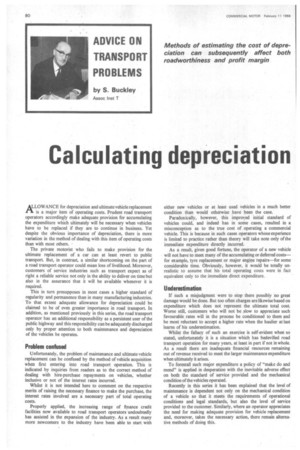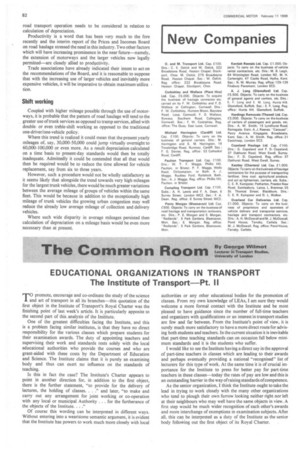Calculating depreciation
Page 82

Page 83

Page 84

If you've noticed an error in this article please click here to report it so we can fix it.
ALOWANCE for depreciation and ultimate vehicle replacement is a major item of operating costs. Prudent road transport operators accordingly make adequate provision for accumulating the expenditure which ultimately will be necessary when vehicles have to be replaced if they are to continue in business. Yet despite the obvious importance of depreciation, there is more variation in the method of dealing with this item of operating costs than with most others.
The private motorist who fails to make provision for the ultimate replacement of a car can at least revert to public transport. But, in contrast, a similar shortcoming on the part of a road transport operator could mean loss of livelihood. Moreover, customers of service industries such as transport expect as of right a reliable service not only in the ability to deliver on time but also in the assurance that it will be available whenever it is required.
This in turn presupposes in most cases a higher standard of regularity and permanence than in many manufacturing industries. To that extent adequate allowance for depreciation could be claimed to be of even greater importance in road transport. In addition, as mentioned previously in this series, the road transport operator has an additional responsibility as a persistent user of the public highway and this responsibility can be adequately discharged only by proper attention to both maintenance and depreciation of the vehicles he operates.
Problem confused
Unfortunately, the problem of maintenance and ultimate vehicle replacement can be confused by the method of vehicle acquisition when first entering into road transport operation. This is indicated by inquiries from readers as to the correct method of dealing with hire-purchase repayments on vehicles, whether inclusive or not of the interest rates incurred.
Whilst it is not intended here to comment on the respective merits of raising the necessary finance-to make the purchase, the interest rates involved are a necessary part of total operating costs.
Properly applied, the increasing range of finance credit facilities now available to road transport operators undoubtedly has assisted in the expansion of the industry. As a result many more newcomers to the industry have been able to start with either new vehicles or at least used vehicles in a much better condition than would otherwise have been the case.
Paradoxically, however, this improved initial standard of vehicles could, and indeed has in some cases, resulted in a misconception as to the true cost of operating a commercial vehicle. This is because in such cases operators whose experience is limited to practice rather than theory will take note only of the immediate expenditure directly incurred.
As a result, given good fortune, the operator of a new vehicle will not have to meet many of the accumulating or deferred costs— for example, tyre replacement or major engine repairs—for some considerable time. Obviously, however, it would be totally unrealistic to assume that his total operating costs were in fact equivalent only to the immediate direct expenditure.
Underestimation
If such a misjudgment were to stop there possibly no great damage would be done. But too often charges are likewise based on expenditure which does not represent the ultimate total cost. Worse still, customers who will not be slow to appreciate such favourable rates will in the process be conditioned to them and be most reluctant to accept a higher rate when the haulier at last learns of his underestimation.
Whilst the fallacy of such an exercise is self-evident when so stated, unfortunately it is a situation which has bedevilled road transport operation for many years, at least in part if not in whole. As a result there are inadequate financial resources remaining out of revenue received to meet the larger maintenance expenditure when ultimately it arises.
To forestall such major expenditure a policy of "make do and mend" is applied in desperation with the inevitable adverse effect on both the standard of service provided and the mechanical condition of the vehicles operated.
Recently in this series it has been explained that the level of maintenance is dependent not only on the mechanical condition of a vehicle so that it meets the requirements of operational conditions and legal standards, but also the level of service provided to the customer. Similarly, where an operator appreciates the need for making adequate provision for vehicle replacement and, moreover, takes the necessary action, there remain alternative methods of doing this. A word of warning should be added here that as with many aspects of commercial vehicle operation, it is inevitable that decisions must be made which, although taken with all the information available, nevertheless are to some extent arbitrary.
Nowhere does this apply more than the estimate of the likely useful life of a vehicle. Additionally for the purpose of articles dealing directly with the cost of operating vehicles, it is not considered appropriate to introduce the subject of tax allowances, particularly as in many cases this would be determined by the accountancy procedure of the company concerned.
A major difference of opinion is whether depreciation should be calculated on a time or mileage basis. For the purpose of compiling the COMMERCIAL MOTOR "Tables of Operating Costs", depreciation is calculated on a mileage basis for both goods and passenger vehicles with the exception of Table 9, which is devoted to cars. In this latter instance it was considered appropriate in line with current business practice to assume annual replacement of cars and calculate depreciation accordingly.
Mileage basis
The reason for calculating depreciation on a mileage basis in all the other eight tables is that physical deterioration of the mechanical condition of a vehicle results largely from wear and tear on the road which in turn is directly related to mileage.
Leaving aside the problem of dealing with exceptional conditions. calculation of depreciation on a time basis admittedly can arrive at similar results. But it is contended that this is the case only because the well-established and efficient road transport operator does so arrange his work that the average weekly mileage, and therefore the average yearly mileage of all his vehicles engaged on similar types of work, is virtually the same. Therefore, although admittedly the word "yearhas basically a time connotation, when used in this sense, the operator concerned automatically will relate that word to, say, 40,000 miles or whatever is his particular average.
Whilst it is not a valid argument to discount either method of calculating depreciation by quoting examples of exceptional conditions—such as mechanical horses spending their entire existence running round factory blocks or vehicles permanently engaged on long-distance work—nevertheless, a possible future trend in road transport operation needs to be considered in relation to calculation of depreciation.
Productivity is a word that has been very much to the fore recently and the interim report of the Prices and Incomes Board on road haulage stressed the need in this industry. Two other factors which will have increasing prominence in the near future—namely, the extension of motorways and the larger vehicles now legally permitted—are closely allied to productivity.
Trade associations have already indicated their intent to act on the recommendations of the Board, and it is reasonable to suppose that with the increasing use of larger vehicles and inevitably more expensive vehicles, it will be imperative to obtain maximum utiliza • tion.
Shift working
Coupled with higher mileage possible through the use of motorways, it is probable that the pattern of road haulage will tend to the greater use of trunk services as opposed to tramp services, allied with doubleor even treble-shift working as opposed to the traditional one-driver/one-vehicle policy.
Where this trend is realized it could mean that the present yearly mileages of, say, 30,000-50,000 could jump virtually overnight to 60,000-100,000 or even more. As a result depreciation calculated on a time basis to present-day standards would then be totally inadequate. Admittedly it could be contended that all that would then be required would be to reduce the time allowed for vehicle replacement, say from six to three years.
However, such a procedure would not be wholly satisfactory as it seems likely that alongside the trend towards very high mileages for the largest trunk vehicles, there would be much greater variations between the average mileage of groups of vehicles within the same fleet. This would be because in addition to the exceptionally high mileage of trunk vehicles the growing urban congestion may wefl reduce the already low average mileage of collection and delivery vehicles.
Where such wide disparity in average mileages persisted then calculation of depreciation on a mileage basis would be even more necessary than at present.
The Common Room




























































































































